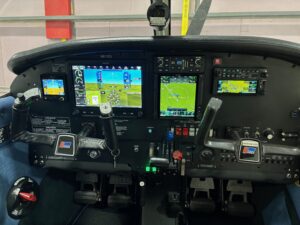Written by Tom Lindfors
In his lifetime, Jay Schrankler has owned five aircraft including a gyroplane he built himself.
He got his first taste of flying as an 8-year-old visiting his grandparents in Columbus, Ohio. His grandfather, Floyd, was friends with an Ohio State Highway Patrol trooper.
“Back then it wasn’t hard to get a ride with my grandfather’s friend. So many times, I went up in the trooper’s Cessna 172 and flew highway patrol with him,” Schrankler recounted. “That sparked my interest (in flying).”
But it was more than flying itself that fascinated Schrankler. It was also the science behind flight.
“In grade school I built a wind tunnel out of orange juice cans and tested wing designs as a science fair project,” Schrankler said.
Schrankler would parlay those passions into a stellar career in aerospace and academia over the next six decades.
According to a report by Grand View Research, the value of the global avionics market was estimated to be $44.68 billion in 2023, and it is expected to continue growing at a compound annual growth rate of 9.7 percent over the next 5-10 years.
That opportunity has not been lost on CEO Jay Schrankler and his team at Perceptive Avionics, recipient of the St. Croix Economic Development Corporation’s 2024 Emerging Business of the Year Award.
“We’re seeing the industry move from analog mechanical to digital electronic,” Schrankler said.
An engineer by training, Schrankler spent 30 years in the aerospace industry at Honeywell where he was responsible for more than $1 billion in sales.
He followed up his success at Honeywell with a stint at the University of Minnesota Venture Center, a business incubator facilitating startups before accepting an “offer he couldn’t refuse” from the University of Chicago Booth School of Business in 2017.
The pandemic in 2021 turned out to be just what Schankler needed. It enabled him to spend a full year away from Chicago at his vacation home on Cedar Lake to build an avionics business in New Richmond. He partnered with Barry Hammarback, a fellow pilot with whom he shared a hangar at the New Richmond Regional Airport (RNH), to form Perceptive Avionics in 2021.
Home to 268 permanently based aircraft, New Richmond is the largest airport in Wisconsin. It is also largely free from the red tape (imposed by the Metropolitan Airports Commission) constricting airports on the Minnesota side of the St. Croix River.
Schrankler credits airport manager Mike Demulling and his staff for the entrepreneurial ecosystem they have cultivated at the airport.
“Mike doesn’t get the credit he deserves,” Schrankler said. “As a leader at the airport, Mike not only said, ‘Yes, but what can I do to help? It’s really something here, very unique.”
With more than 200 planes hangared at RNH, Schrankler recognized an avionics business could thrive.
In 2017 Schrankler met Lucian Banitz. At the time, Banitz was serving as the Director of Flight Operations for Mavrx, a company also operating out of RNH that provided aerial imaging services for agricultural clients across the country.
“It was astonishing to see Lucian here, a Silicon Valley guy who had moved a company to this area, along with EPS and a couple other small companies including NDT Solutions that had been established earlier at the airport,” Schrankler said. “The airport community here was very welcoming to new ideas, innovation and entrepreneurship. I thought, there’s something special happening here.”
In January 2025 Banitz bought out Hammarback’s share in Perceptive Avionics to co-own the company with Schrankler.
Progress in aviation is measured because of the regulatory standards and safety requirements imposed by authorities like the Federal Aviation Administration (FAA).
But the regulations also mandate the adoption of cutting-edge avionics systems to improve safety and reliability and to ensure compliance and that drives the demand for new technology.
According to Schrankler, the driving force behind putting LCDs in aircraft was driven by large capital investments in 1990 by Boeing and Honeywell. The latter invested $100 million into developing flat panel displays for aircraft while securing 270 patents in the process.
In 2020 the FAA mandated Automatic Dependence Surveillance – Broadcast (ADS-B). ADS-B employs next generation avionics including GPS, satellite and computer processing capabilities to communicate the position, speed, heading, altitude and call sign of aircraft in frequent intervals to a network of ground stations. This new technology is transforming how Air Traffic Control (ATC) operates and phasing out its reliance on radar, the standard in aviation for decades.
Those complex radar systems used by larger commercial airports were cost-prohibitive for smaller airports without manned control towers like New Richmond. That meant during adverse weather, most of its small aircraft could not take off or land at the airport.
The new digital technology has only become affordable for small aircraft owners in the last 6-8 years. Upgrading not only makes economic sense it adds capability to the aircraft and makes flying it safer.
“This latest round of technology which now incorporates all the modern solid-state electronics and high-definition screens initially reserved for commercial and corporate aircraft makes it possible for everybody to have really advanced guidance equipment and controls for their aircraft,” Banitz explained. “It does a lot for safety and situational awareness for the pilot.”
Advancements in avionics technology including touch-screen interfaces, next-generation flight management systems and advanced connectivity solutions have enabled regional airports like New Richmond to become a viable base for corporate jet services that depend on flying regardless of weather conditions to be profitable.
A new basic four-seat plane costs more than a million dollars in today’s market and makes retrofitting an older plane with new avionics a smart decision.
“The average age of the general aviation fleet in this country is roughly 30 years,” Banitz said. “It’s far more cost effective to upgrade the airplane to modern avionics than to purchase a new airplane. Even though the upgrades are expensive they’re only a fraction of the cost to buy a new plane.”
“When people change airplanes, it’s different from what we do. We can take an existing old airplane and make it like the next new airplane,” Schrankler said. “We are unique and one of our goals is to grow this business to be really big.”
Perceptive Avionics provides pilots with a highly personalized process. It is not a one-size-fits-all solution. It starts with inventorying what a particular plane has equipment and instrument wise, determining what capabilities the pilot requires, the new technology options available to meet those needs and accommodating his budget.
Pilots typically work through several iterations with Schrankler’s team before arriving at the optimal configuration.
“The customer drives the timeline and will frequently ask for our advice,” Schrankler said.
Banitz added, “The fact that we are also pilots is an essential part of being able to do this job.”
Once the tech is matched with the needs, a customized installation takes place to ensure the new digital tech communicates reliably with the mechanics of the aircraft.
Before they hand the keys back to the pilot, Perceptive Avionics makes sure he is comfortable with his new interface.
“We’re unique in that respect. We offer two hours of complimentary training in your airplane. It’s included in your purchase.” Schrankler said. “There are also simulators that you can put on your iPad so you can simulate what the new configuration will look like, how it will perform and practice using it.”
What’s Next
Schrankler and Banitz are focused on accelerating the growth of their business. They expect to be moving into a new facility this summer triple the size of their current facility.
“In the next three years, we should have up to 11 people employed here. That’s doubling our workforce in the next three years,” Schrankler said.
They are also looking to expand their partnerships with flight schools where they train pilots to take care of their aircraft and help upgrade the avionics in the school’s fleet of aircraft.
Stemming from their receipt of Garmin’s coveted Bronze Award for sales and service based on customer feedback, they are looking to benefit from potential partnerships facilitated by Garmin with other companies around the state to retrofit additional aircraft.
Schrankler and Banitz also devote time to experimenting and developing new products they hope to someday bring to the market. Schrankler calls it their Skunk Works®, a tribute to Lockheed Martin’s legendary think tank responsible for “developing aircraft systems that push the boundaries of what’s possible.”
“We come up with these ideas and rather than let them go to waste, we see if we can develop some of our own products, something we would probably spin out of the business down the road,” Schrankler said.
Community – Math meets Imagination
“The nice thing about aviation is it covers so many disciplines in STEM from fluid dynamics and physics principles to power and engineering,” Schrankler said.
When he is not busy designing a custom avionics package for a customer, you can find Banitz introducing kids to aviation using model airplanes.
In December he hosted 10 kids ages 5-16 yrs for a build day at the airport. Working with the local Experimental Aircraft Association (EAA) Chapter, he helped kids build free flight gliders out of foamboard kits he laser cut for them. The day started with education about the principle of flight emphasizing the need for balance between the wings and tail of an airplane.
By the time the gliders took flight, everyone had been modified from its stock configuration.
“You’d be surprised to see what flies if you balance it properly,” Banitz said.
Just the Facts:
Perceptive Avionics Corp
Jay Schrankler – CEO
Lucian Banitz – Co-Owner
Formed: 2021
Address:
625 West Hangar Road
Hangar 16 -1
New Richmond, WI 54017
Phone: 715-338-4080
Website: https://perceptiveavionics.com/
Employees: 5
Sq. ft.: 3,600 (10,000 June 1, 2025)

Perceptive Avionics Team: (L-R) Lucian Banitz, Jay Schrankler, Rob Nourse, Austin Buhr

Solid-state electronics and high-definition screens initially reserved for commercial and corporate aircraft makes it possible for small plane pilots to have advanced guidance equipment and controls for their aircraft.

